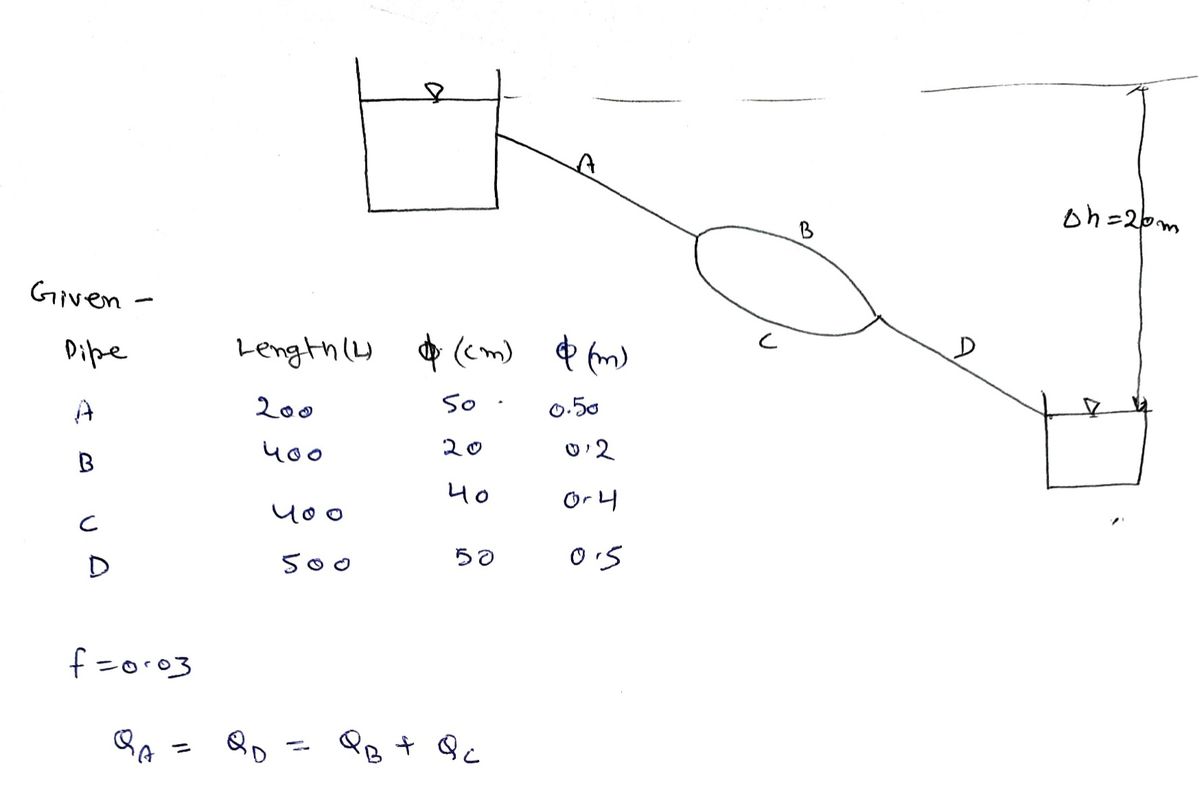S Pipe B C T A Length 200 400 400 500 ... LT с ( (cm) 50 20 40 50 e) Solve for Q₁ K Assume f= 0.030 for all fipes Megate hm terms of QB 7 Q₁ = QD -> QD in QA = QB +Qc → Solve for QA in terms of QB huB =h₂c -> Use Darcy - Weisbach to get hLA thee the = h total Solve for 48:15 Q₁, QA & QD 20m QB & Qc relationship Δη НОС
S Pipe B C T A Length 200 400 400 500 ... LT с ( (cm) 50 20 40 50 e) Solve for Q₁ K Assume f= 0.030 for all fipes Megate hm terms of QB 7 Q₁ = QD -> QD in QA = QB +Qc → Solve for QA in terms of QB huB =h₂c -> Use Darcy - Weisbach to get hLA thee the = h total Solve for 48:15 Q₁, QA & QD 20m QB & Qc relationship Δη НОС
Chapter2: Loads On Structures
Section: Chapter Questions
Problem 1P
Related questions
Question

Transcribed Image Text:## Pipe Flow Analysis
This image illustrates a network of pipes and demonstrates methods for analyzing fluid flow within the system. Below is a detailed transcription and explanation:
### Diagram Explanation
The diagram features a schematic representation of a pipe system, consisting of four different pipes (A, B, C, and D) with specified lengths and diameters:
- **Pipe A**: Length = 200, Diameter = 50 cm
- **Pipe B**: Length = 400, Diameter = 40 cm
- **Pipe C**: Length = 400, Diameter = 20 cm
- **Pipe D**: Length = 500, Diameter = 50 cm
Two reservoirs are depicted at either end of the pipe network, with a height difference of 20 meters, indicated as \( \Delta h = 20m \).
### Assumptions
- Friction factor, \( f = 0.030 \) for all pipes.
- Neglect minor losses.
### Mathematical Equations and Approach
1. **Flow Equations**:
- \( Q_A = Q_D \)
- Express \( Q_D \) in terms of \( Q_B \).
2. **Continuity Equation**:
- \( Q_A = Q_B + Q_C \)
- Use the Darcy-Weisbach equation to establish a relationship between \( Q_B \) and \( Q_C \).
3. **Head Loss Equations**:
- \( h_{LB} = h_{LC} \)
- Total head loss: \( h_{LA} + h_{LB} + h_{LD} = h_{total} \)
4. **Solution Approach**:
- Solve for \( Q_B \).
- Subsequently, solve for \( Q_A, Q_B, \) and \( Q_D \).
This analysis involves applying fluid mechanics principles to determine flow rates and the distribution of head loss across different sections of the pipe network. By using the given pipe dimensions, friction factor, and assumptions, engineers can solve for flow variables and optimize the design of the system.
Expert Solution
Step 1

Step by step
Solved in 4 steps with 3 images

Knowledge Booster
Learn more about
Need a deep-dive on the concept behind this application? Look no further. Learn more about this topic, civil-engineering and related others by exploring similar questions and additional content below.Recommended textbooks for you


Structural Analysis (10th Edition)
Civil Engineering
ISBN:
9780134610672
Author:
Russell C. Hibbeler
Publisher:
PEARSON

Principles of Foundation Engineering (MindTap Cou…
Civil Engineering
ISBN:
9781337705028
Author:
Braja M. Das, Nagaratnam Sivakugan
Publisher:
Cengage Learning


Structural Analysis (10th Edition)
Civil Engineering
ISBN:
9780134610672
Author:
Russell C. Hibbeler
Publisher:
PEARSON

Principles of Foundation Engineering (MindTap Cou…
Civil Engineering
ISBN:
9781337705028
Author:
Braja M. Das, Nagaratnam Sivakugan
Publisher:
Cengage Learning

Fundamentals of Structural Analysis
Civil Engineering
ISBN:
9780073398006
Author:
Kenneth M. Leet Emeritus, Chia-Ming Uang, Joel Lanning
Publisher:
McGraw-Hill Education


Traffic and Highway Engineering
Civil Engineering
ISBN:
9781305156241
Author:
Garber, Nicholas J.
Publisher:
Cengage Learning